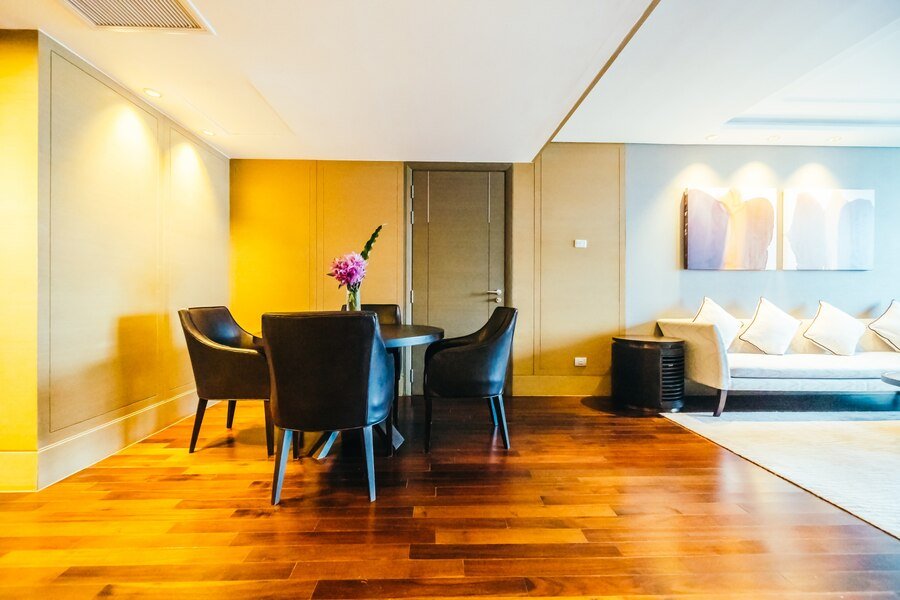Indoor wood flooring has become a popular choice for modern homeowners seeking to blend aesthetics with sustainability. As environmental concerns grow, many are turning to eco-friendly options that not only enhance the beauty of their living spaces but also minimize their ecological footprint. From traditional hardwood to innovative bamboo, the market offers a wide array of sustainable wood flooring solutions that cater to diverse tastes and budgets.
This article delves into the world of sustainable indoor wood flooring, exploring various options and their environmental impact. It examines top eco-friendly choices, including engineered hardwood and reclaimed timber, and discusses factors like the Janka hardness scale and wood grain patterns. Additionally, it covers maintenance tips to extend the longevity of wood floors and touches on water protection and scratch resistance. By the end, readers will have a comprehensive understanding of how to make informed decisions when selecting sustainable wood flooring for their homes.
Understanding Sustainable Wood Flooring Options
Sustainable wood flooring offers homeowners an environmentally responsible choice that combines aesthetics with eco-consciousness. These options prioritize responsible forestry practices and minimize environmental impact throughout the product’s lifecycle.
FSC-certified wood
The Forest Stewardship Council (FSC) certification ensures wood comes from responsibly managed forests. FSC-certified products adhere to strict environmental and social standards, making them a trustworthy choice for sustainable flooring. This certification guarantees that forests are managed to keep them intact and healthy for both people and wildlife. FSC-certified wood also offers several benefits, including better insulation properties compared to other building materials.
Reclaimed wood
Reclaimed wood flooring repurposes timber from old buildings, barns, or factories. This option not only adds unique character to living spaces but also reduces demand for new trees to be cut down. Reclaimed wood helps clean up buildings and natural spaces, preventing wood waste from ending up in landfills. It also requires fewer resources for manufacturing compared to freshly cut trees, resulting in a lower environmental impact.
Rapidly renewable wood species
Some wood species grow quickly, making them more sustainable choices for flooring. Bamboo, for example, matures in just 3-5 years and can be harvested sustainably without disturbing the roots. Other fast-growing options include eucalyptus and cork. These rapidly renewable species offer durability and beauty while ensuring a more sustainable approach to wood flooring.
By choosing sustainable wood flooring options, homeowners can enjoy the warmth and beauty of wood while minimizing their environmental footprint.
Top Eco-Friendly Wood Flooring Choices
Bamboo flooring
Bamboo has become a popular choice for eco-conscious homeowners seeking sustainable flooring options. This versatile grass grows rapidly, reaching maturity in just 3-5 years, making it a highly renewable resource. Bamboo’s impressive growth rate allows it to sequester carbon more efficiently than hardwood trees, with some estimates suggesting it can store up to 70% more carbon per acre annually.
Bamboo flooring offers excellent durability, often surpassing traditional hardwoods in hardness. Through compression treatment techniques, bamboo can achieve greater tensile strength than oak, making it resistant to dents and scratches. This durability contributes to its sustainability by reducing the need for frequent replacements.
Cork flooring
Cork flooring stands out as another environmentally friendly option. Harvested from the bark of cork oak trees without harming the tree itself, cork is a truly renewable resource. Cork oak forests act as carbon sinks, absorbing and storing carbon dioxide from the atmosphere. In many cases, the carbon produced during manufacturing and transportation is offset by the forests, potentially making cork flooring carbon-negative.
Cork flooring offers unique benefits, including natural insulation properties that help reduce energy costs. Its cellular structure provides excellent sound absorption, making it ideal for noise reduction. Cork also has antimicrobial properties, helping to reduce household allergens and improve indoor air quality.
Engineered wood flooring
Engineered wood flooring combines sustainability with the aesthetic appeal of hardwood. It consists of a real hardwood veneer layer bonded to multiple layers of high-quality plywood or high-density fiberboard. This construction uses less hardwood than solid wood flooring, reducing the demand for lumber and helping to preserve forests.
Many engineered wood manufacturers prioritize sustainable forestry practices, sourcing wood from responsibly managed forests. The stability of engineered wood makes it less susceptible to warping and buckling, extending its lifespan and reducing the need for replacements. To ensure maximum eco-friendliness, look for certifications like FSC, Greenguard, and CARB Phase 2 when selecting engineered wood flooring.
Evaluating the Environmental Impact of Wood Flooring
Carbon Footprint
Wood flooring has a relatively low carbon footprint compared to other flooring options. Trees, the raw material for wood floors, absorb and store carbon dioxide during their growth, making wood flooring carbon neutral according to the U.S. Department of Agriculture. In fact, hardwood forests in the United States are growing at more than twice the rate they are being harvested, ensuring a sustainable supply.
A life-cycle assessment of solid hardwood flooring revealed that it releases 26.65 kg CO2eq per square meter over its entire life cycle. However, when considering biogenic carbon emissions, this impact decreases to 12.27 kg CO2eq due to carbon storage in landfills. Each square meter of solid hardwood flooring consumes 610.5 MJ of energy, with about 20.3% coming from renewable sources, primarily biomass.
VOC Emissions
Volatile Organic Compounds (VOCs) are a concern in indoor environments, as they can have adverse health effects. Wood flooring and its associated products, such as adhesives and finishes, can emit VOCs. These emissions can contribute to indoor air pollution, potentially causing eye, nose, and throat irritation, headaches, and in some cases, more severe health issues.
To mitigate VOC emissions, it’s crucial to choose low-VOC or zero-VOC products for wood flooring installation and maintenance. Many manufacturers now offer products that comply with strict VOC regulations, particularly in states like California where regulations can vary by county.
End-of-Life Recyclability
Wood flooring offers several environmentally friendly disposal options at the end of its service life. It can be recycled into other materials, used as fuel for heating, or, if it ends up in a landfill, it will biodegrade, reducing its long-term environmental impact. One of the most sustainable practices is using reclaimed wood for flooring, which repurposes old wood from various sources, reducing the demand for new raw materials and preserving the unique character of the wood.
Maintenance and Longevity of Sustainable Wood Floors
Proper care techniques
Maintaining sustainable wood floors is crucial for their longevity. Regular cleaning with mild, manufacturer-recommended solutions helps prevent damage and preserve their natural beauty. It’s essential to avoid harsh chemicals that can strip away protective finishes. Promptly cleaning up spills prevents moisture penetration and potential damage. Using protective pads or felt sliders under furniture legs and placing area rugs in high-traffic areas reduces wear and tear.
Refinishing options
Refinishing wood floors is a valuable practice that extends their lifespan and enhances durability. This process can lead to a remarkable reduction in carbon emissions by up to 79% compared to complete replacement. Eco-friendly refinishing methods include water-based finishes, dustless floor sanding, and natural oils. These options improve indoor air quality and offer customization possibilities, allowing homeowners to adapt their floors to evolving design preferences.
Durability factors
The durability of wood flooring is significantly impacted by its hardness. Harder woods like Hickory are known for their resistance to wear and tear. Proper maintenance, including controlling indoor humidity levels between 35% and 55%, is vital for preventing excessive expansion or contraction of the wood. With appropriate care, wood floors can last over 100 years. Regular inspections help identify issues early, allowing for prompt maintenance. By implementing these practices, homeowners can ensure their sustainable wood floors withstand the test of time and continue to provide long-term value.
Conclusion
Sustainable wood flooring has a significant impact on modern homes, blending beauty with eco-consciousness. The range of options, from FSC-certified wood to rapidly renewable species like bamboo, allows homeowners to make choices that align with their environmental values. These flooring solutions not only enhance the aesthetic appeal of living spaces but also contribute to reducing carbon footprints and promoting responsible forest management.





